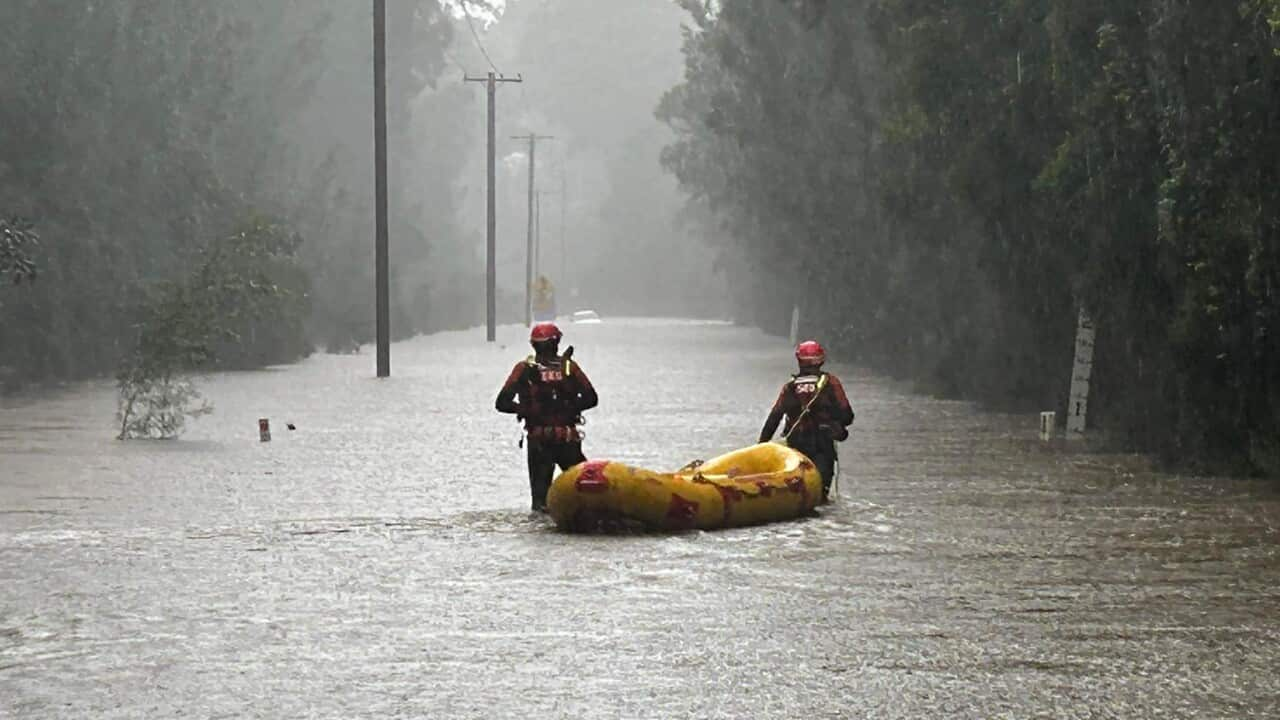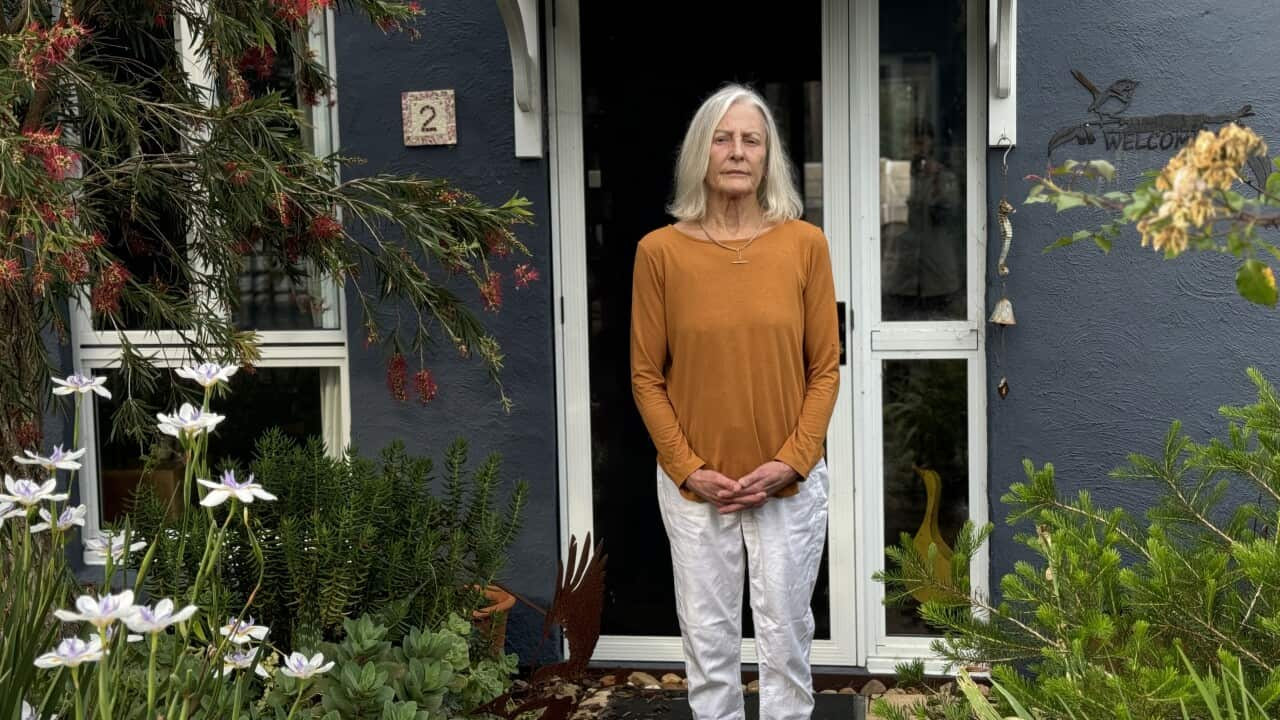

10 min read
Feature
'Inside I was screaming': The unexplored trauma of sudden and extreme weather
Donna Andrews lost her house in a bushfire in 2020. She says the mental health challenges from living through a climate-related disaster have been profound and ongoing.
Published
By Elfy Scott
Source: SBS News
Image: Donna Andrews says she was racing flames as she escaped a bushfire in Bundanoon in January 2020. (SBS News / )
The approaching fire looked nothing like Donna Andrews had expected.
Instead of seeing a front of flames burning over the distant hills of the NSW Southern Highlands where she lives, she saw a cloud growing.
Andrews and her husband, John, had been told at a town hall meeting days earlier that they had time; the flames were still days away.
But on the evening of 3 January 2020, a pyrocumulonimbus cloud — a violent thunderstorm generated by the energy of bushfires raging on the ground — grew in the sky.

The pyrocumulonimbus cloud approaching Bundanoon in January 2020. Credit: Supplied
We can see for miles, and there was no fire. And then all of a sudden we were on fire.
Beyond the windows of their small wooden country home in the small town of Bundanoon, there was now thick smoke.
"And then our neighbour rang and said: 'We're on fire. Get out, get out'."
The couple raced around their home, grabbing what they could and hauling chickens into their cars before pulling out onto Bundanoon Road.
They were surrounded by spot fires and by the time they were driving, they were racing the flames.
At one point, Andrews saw her husband, who was ahead of her, drive through a wall of fire across the road. She says she watched him disappear and stopped the car for a moment, although it felt much longer to both of them.
I thought: 'Are you driving into hell?' And then I thought if I stay where I am, I'm not going to survive, so I put my foot down and went in.
"But John was on the other side, he was up there, and still can't talk about this part because he went through it and then I didn't come through because I'd stopped, and that's very distressing for him still."
The pair stayed with friends in nearby Bowral that night, and while they weren't allowed to drive back to the property the next day, they soon discovered what had happened to it.

The only parts of Donna Andrews' house left standing were two chimneys. Credit: Supplied
"I really couldn't believe that this was our life when John was nudging retirement right then. We just all of a sudden have nothing — we couldn't really process it, to be honest."
In the months and years after the fires, the couple faced setback after setback trying to rebuild their lives. The COVID-19 pandemic was declared internationally just weeks later and the couple moved through five rentals in four years while they tried to rebuild their home.
Andrews says people complimented her on her patience while she was stuck in this agonising limbo.
Inside, I was screaming, 'I'm not patient, I've got no choice do I!'
Andrews endured months of deep sadness and distress, not only due to her personal loss but also in reflecting on what was happening to the world around her as a result of man-made climate change.
"We had a government that wasn't really interested really in the grand scheme of things. I was distressed that big business was always taking the priority and short-term gains were always the priority, not the long-term vision," she says.
"And that was a bitter pill to swallow when you've been through something like this."

The aftermath of the bushfire on Bundanoon Road. Credit: Supplied
During pandemic lockdowns, Andrews was referred to one online session with a psychologist. She remembers the psychologist telling her she was doing "pretty good".
"I was like: 'Yeah, right, okay'. And I thought I was sort of all right — but clearly I've been affected and it will stay with me," she says through tears.
- This is part two of a three-part series exploring the adverse impacts of climate change on mental health and wellbeing.
The trauma of climate change disasters
The mental health of communities can be impacted profoundly by natural disasters.
One study from the Australian National University (ANU) that tracked the mental health and wellbeing of the Australian community over the 12 to 18 months following the 2019-2020 Black Summer bushfires found high levels of depression, anxiety, stress and post-traumatic stress disorder (PTSD).
Among those who were directly affected by bushfires, one in five reported symptoms that met the clinical threshold for PTSD.

Depression, anxiety and post-traumatic stress disorder were seen in communities affected by the Black Summer bushfires. Source: AAP / Mick Tsikas
Dr Timothy Heffernan, an anthropologist from the University of New South Wales and lead author of the ANU study, says that even after the initial post-traumatic stress symptoms subside, people in disaster-ravaged communities can still experience 'maladjustment' and fail to settle back into their everyday lives.
"People don't adjust back to life that well. They're kind of a little bit on edge, they're kind of distrustful, and there are certain other symptoms that come along with that," Heffernan explains.

Evacuees from Mallacoota, Victoria, during the Black Summer bushfires in January 2020. Source: AAP / LSIS Shane Cameron/EPA
Heffernan says intense loneliness, broken social circles and relationship breakdowns can all follow a disaster experience.
Disasters can also make people feel differently about the world around them and their outlook on life can change.
One respondent in a 2023 Climate Council study, which surveyed people who had experienced extreme weather disasters, reported they felt a: "huge sense of aloneness, fear and despair that this is going to be our future".
Heffernan says people who see the environment around them burn or flood can also experience 'solastalgia' — the feeling of losing peace with the world around you.
Often, Heffernan says, people will move into disaster-prone environments because they find them beautiful or comforting — and climate events can dramatically alter that feeling.
Andrews says even though Bundanoon still feels like home, she was left with a strange sensation after seeing it destroyed. She remembers looking at how the fire had travelled in swirling patterns across paddocks.
While solastalgia isn't a formal diagnosis, it can explain another sense of alienation that people feel in the natural environment following disasters.

Dr Timothy Heffernan believes residents of Los Angeles may experience a sense of 'solastalgia' after the widespread fires in January. Source: AAP / Michael Nigro/Sipa USA
Trees have burned down, whole forests have been impacted, birds haven't returned and people feel this sense of you're living in a different landscape.
Heffernan predicts that over the coming months, the Los Angeles communities affected by the rapid infernos that started sweeping through the city in January will find the places they once chose to live may no longer resemble home.
'Surge' mental health support
While state and territory governments often provide crisis support following a disaster, experts say these programs are not sustained in the long-term.
Heffernan says that while a "surge" of psychological resources can be deployed to areas after natural disasters, they're often only available for a "bureaucratic timeline" of one or two months.
Professor James Bennett-Levy, a researcher from Southern Cross University who lives in the NSW Northern Rivers region, says that when psychological support is made available, it's typically at a time when people affected by disasters are dealing with other priorities, such as housing, employment, and caring for children.

Severe flooding in the NSW Northern Rivers region in 2022 caused widespread anxiety in some communities, Professor James Bennett-Levy says. Source: AAP / Jason O'Brien
After living through the , which caused mass destruction and claimed multiple lives, Bennett-Levy says anxiety is still widespread in the community.
Those who were directly impacted, lost homes or experienced life-threatening moments are still "on tenterhooks".
"They may have images of past traumatic events running through their minds; they at other times may experience sleep problems, nightmares. Any reminders will cue them or can potentially cue them into high levels of anxiety and emotional upset," he says.
LISTEN TO

1. Burnt: No Ordinary Fire
SBS News
28:21
These emotional responses can cause people to become "radically disconnected" from their communities and intensify the mental health impacts of these disasters, Bennett-Levy says.
In May 2024, Bennett-Levy and his team at Southern Cross University received a $3.8 million grant over four years to run art therapy groups, nature-based therapy and MDMA-assisted therapy for people suffering continued mental health challenges associated with the catastrophic floods.
Bennett-Levy believes providing these avenues for people to recover psychologically from disaster can not only provide a way to reconnect but can build all-important foundations of self-compassion.
"When you develop mental health problems, and you're looking around you and you're saying: 'Other people seem to have kind of got it back together but I haven't', then one of the things that happens is that you start to get pretty highly self-critical or [develop] feelings of shame — and that really locks in mental health problems," he says.

Professor James Bennett-Levy and his team will establish therapy groups for people in Lismore continuing to suffer the ongoing mental health impacts caused by the 2022 floods. Source: AAP / Jason O'Brien
Communities are integral to recovery
While many people may find themselves disconnected from their communities and neighbourhoods in the wake of climate disasters, Heffernan says maintaining these connections is fundamental to recovery.
People embedded in communities can lean on others to talk, dissect traumatic events, recover and help rebuild their lives.
The more connected a community is before a disaster, the better off they're going to be later on.

Donna Andrews says she has found meaning in climate action since losing her house in a bushfire. Source: SBS News
In the years since, she has found meaning and belonging in her activism, which she started with the organisation Bushfire Survivors for Climate Action. She says she has faith that sharing her story can play its part in calling for climate action.
"There are good things that come out of tricky situations and having a voice and being able to use it is a good thing," she says.
LISTEN TO

LA wildfires deemed most destructive in Southern California's history
SBS News
04:38
However, Andrews says she also feels as though the mental health impacts of climate-related disasters are not taken seriously enough by the government.
She says that even people who haven’t been directly impacted by climate disasters can experience significant distress.
"Sydney was smothered in smoke for months [during the 2019-20 bushfire season]. I understand it impacts people and there's no level that's right or wrong for anyone," she says.
"We've all been through stuff and I think there are a lot of people that were impacted by it."



